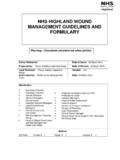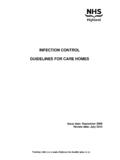Transcription of Personality Disorder Integrated Care Pathway - NHS Highland
1 Personality DisorderIntegrated Care Pathway (PD ICP)3:Assessment, diagnosis and formulationJuly 2015 AcknowledgementsThis document was produced by a partnership of NHS Highland staff, volunteers, service usersand staff from other public and third sector NHS Highland Personality Disorder Service will coordinate future reviews and updates ofthis Highland would like to thank everyone involved in the creation of this 2015 Contents3 Assessment, diagnosis and of assessment .. F60 Personality Disorder ICD-10 (DCR-10) General Criteria for Personality Paranoid Personality Schizoid Personality Dissocial Personality Emotionally Unstable Personality Disorder , Impulsive Type.. Emotionally Unstable Personality Disorder , Borderline Histrionic Personality Anankastic Personality Anxious (Avoidant) Personality Dependent Personality Personality Disorder , Mixed Personality DSM-IV specific criteria for Borderline Personality Assessment, diagnosis and IntroductionPersonality Disorder and Personality -related conditions are by their very nature complex.
2 Theirinherent complexity means that these conditions often require relatively more time to assessthan many other disorders. Three to four sessions to assess and formulate is not diagnosis, formulation and treatment planning maximises the chance of recovery fromthese chronic conditions, which are associated with so much distress, poor functioning andresource Disorder should no longer be viewed as a diagnosis of exclusion. In other words, itshould be considered as a diagnostic possibility from an early point in the assessment process,rather than only receiving consideration later in the process when other diagnoses have beenexcluded. Early consideration of the diagnosis helps to avoid situations where patients receiveinappropriate, unnecessary and sometimes harmful undoubtedly essential, diagnosis should constitute only one part of a broader formulationof an individual s situation, their condition and their needs.
3 In general terms, it is more importantto identify the presence of Personality Disorder and to assess its severity than to subtype intospecific Personality categories. Personality Disorder presents with certain symptoms which arepredicated upon the interaction of an individuals Personality traits and their environment. It isimportant to assess both symptoms and SymptomsSymptoms occur as a result of maladaptation of the Personality to the environment. It is helpfulto think in terms of four broad headings: cognitive-perceptual (for example, excessive suspiciousness) affective (for example, emotional instability and anger difficulties) interpersonal relationship with self/sense of self interpersonal relationships relationship with society behavioural/impulse control (including self-harm and suicidal behaviour) Personality TraitsA Personality trait (or variable) is a complex structure which represents the basic building blockof Personality .
4 In a given individual, genetic and environmental factors transact to form acomplex biopsychological system which produces observable trait-based , a Personality trait represents a disposition to behave in a particular way. The term isalso sometimes used to refer to individual features of specific Personality Disorder , especiallywhen the full diagnostic criteria are not met. For example, someone meeting four of the fivecriteria needed for a diagnosis of borderline Personality Disorder may be referred to as having borderline traits .Some traits which are of particular importance in Personality Disorder are listed below with briefdescriptions of associated behaviours. Traits can be usefully organised into four main higherorder trait domains: (emotionally) dysregulated, detached, dissocial, and compulsive. There maybe overlap between some traits and it is worth noting that some of the names used for particulartraits may have different meanings when used in other contexts.
5 The traits below are drawn fromthe Personality Assessment Schedule (Tyrer, 2000).Other sources may label particular is important to remember that no Personality trait is inherently negative . Many traits can bedescribed by more than one term, some with negative connotations and some with positiveconnotations. For example: impulsive versus spontaneous; stubborn versus determined; aloofversus self-contained and so on. Problems arise when a person s Personality traits aremaladapted to their environment. With more extreme expressions of particular traits,maladaption is likely in a greater number of environments leading to greater severity ofpersonality (Internalising) DomainPessimism holds a pessimistic outlook on feelings of inferiorityLability mood instabilityAnxiousness anxiety-pronenessShyness shyness and lack of self-confidenceSensitivity personal sensitivity and tendency to self-referenceVulnerability experiences excessive emotional distress when faced with adversityChildishness excessive self-centerednessResourcelessness tendency to give up when faced with adversityDependence excessive reliance on others for advice and reassuranceSubmissiveness limited ability to express own views or stand up foroneselfHypochondriasis over-concern about illness and healthDetached (Schizoid/inhibited)
6 DomainSuspiciousness excessive mistrust of othersIntrospection prone to rumination and fantasyAloofness detachment and lack of interest in other peopleEccentricity oddness in behaviour and attitudes; unwilling or unable toconformDissocial (Externalising) DomainOptimism unrealistically optimistic, over-confident, excessively self-importantIrritability excessively irritableImpulsiveness excessive impulsivenessAggression excessive levels of (physical) aggressionCallousness indifferent to the feelings of othersIrresponsibility indifferent to the consequences of one s behaviourCompulsive (Anankastic) DomainConscientiousness overly fussy, perfectionisticRigidity inflexibility and difficulty adjusting to new Areas of AssessmentAssessment for specific interventions may vary in emphasis but will generally cover the areas inthe general assessment below.
7 While it is recognised that a comprehensive assessmentincluding all the components listed below may not be possible in every case, a detailed generalassessment of Personality Disorder will typically include information gathered from four mainsources: psychiatric history and mental state examination; collateral information; formalstructured assessment tools; and clinician observations. Detailed psychiatric history and mental state examinationincluding: Important developmental and interpersonal factors such as:oFamily and parental relationships including attachment patternsoReactions to key developmental events and transitionsoLosses, separations, relocations and responses to such eventsoPreliminary assessment of history trauma and neglect. Full exploration atassessment stage can be dysregulating and counterproductive if the patientdoes not have adequate self-regulatory skills.
8 However, the patient should bemade aware that traumatic events can be returned to in due course. Aninstrument such as theTrauma History Screen(Carlson et al., 2011) may beuseful in gaining a trauma and romantic relationshipsoImportant memories Co-occurring disorders:oAxis 1 Post-traumatic conditions Reliving experiences Constriction/avoidance Hyperarousal Substance use Other mental illnessoPhysical health conditions Risk assessment: consider using a structured tool such asSTORM Personal strengths and attributes Motivation to change Symptoms: current difficulties or disturbance in the following domains:oCognitive/perceptualoAffectiveo Interpersonal Relationship with self/sense of self Interpersonal relationships Relationship with societyoBehavioural/impulse control Traits: traits underlie the symptoms and can be grouped into 4 domains:oDysregulated (internalizing)oDissocial (externalizing)oDetached (schizoid)oCompulsive (anankastic) Collateral information.
9 Healthcare records Informant information from (as appropriate):oFamilyoFriends and acquaintancesoProfessionals Clinician observations: Of interactions with others Within clinical encounters Formal structured assessment toolsto be used where appropriate include : core -Outcome Measure ( core -OM):self-reported general measure of well-being,problems, risk and functioning. This comes inCORE-34(34 item) andCORE-10(10item) forms. ( core , 1998) Global Assessment of Functioning(GAF):clinician-completed global assessment offunctioning on 0-100 scale. This represents axis 5 of DSM-IV (DSM-IV, 1994). Zanarini Rating Scale for Borderline Personality Disorder (ZAN-BPD):cliniciancompleted semi-structured interview for borderline Personality Disorder based on the 9 DSM-IV criteria (Zanarini, 2003). Borderline Estimate of Severity over Time (BEST):self-reported measure of bor-derline Personality Disorder used in STEPPS.
10 This measure is reasonably sensitive tochange as it includes items relating to adoption of more adaptive behaviours. (Pfohl andBlum, 1997). WHOQOL-BREF:self-report quality of life measure (WHO, 2004). Filter Questionnaire:self-report tool for presence of unhelpful core beliefs typicallyassociated with borderline Personality Disorder (from STEPPS, Blum et al., 2008). Personality belief Questionnaire (PBQ):self-report tool for presence of unhelpful corebeliefs associated with a broad range of Personality disturbance (Beck, 2001) Process of Recovery Questionnaire(PRQ):Self-report measure of recovery (Neil etal., 2007) Standardised Assessment of Personality Abbreviated Scale(SAPAS):short self-report screening tool for presence of Personality Disorder (Moran, 2003). Trauma History Screen(THS):self-report instrument assessing nature and severity ofhistorical traumatic events.







